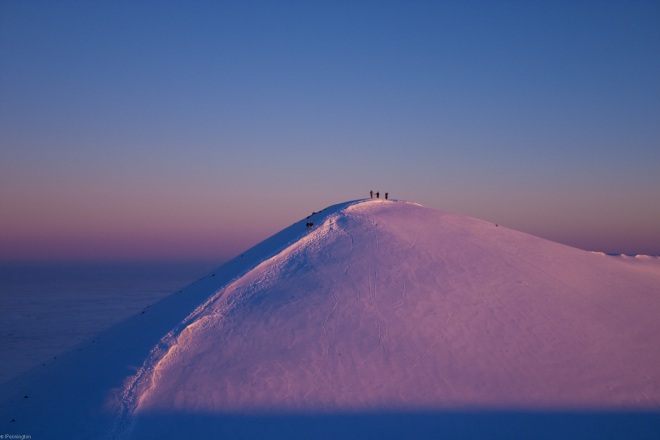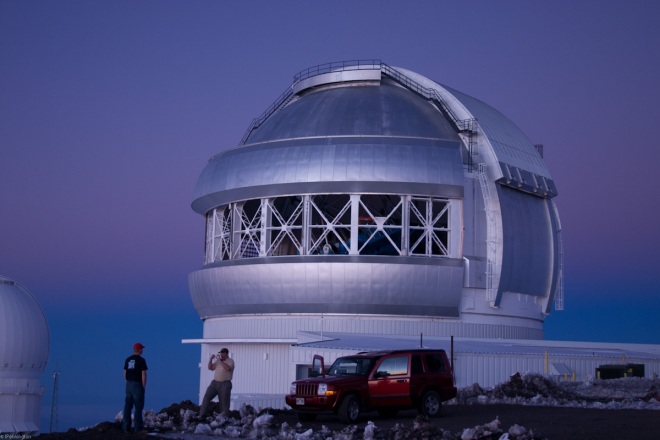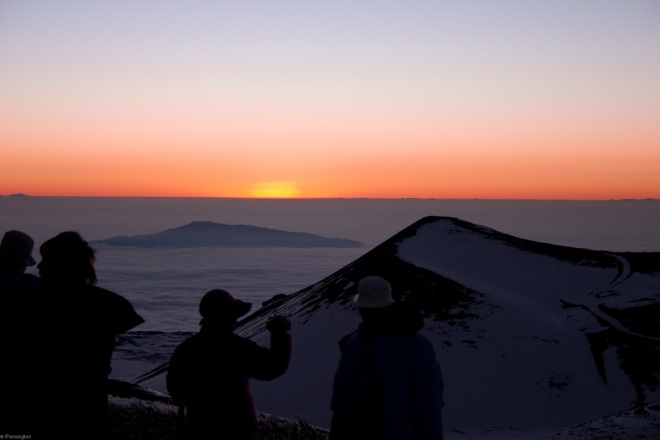My teeth can’t stop chattering. I’m in Hawaii and freezing while watching the sun go down above the clouds on the summit of Mauna Kea, a dormant volcano on the Big Island. We’re at 13,796 feet (that’s more than 4.2 kilometres up, for us metric folks). The air is thin, the landscape is out of this world and the view is spectacular.

The Hawaiians consider Mauna Kea,or the White Mountain, one of the island’s most sacred spots where shrines, burial sites and the largest and best preserved adze or stone axe quarry (dating to about AD 1100) in the Hawaiian islands can be found. The goddesses Poli‘ahu (snow) Lilinoe (mist and fog) and and Li–hau (cold chill) dwell here, according to Hawaiian legends. The summit also hosts the world’s largest astronomical observatory, with telescopes operated by 11 countries, including the United States, Canada, Japan, France, and the United Kingdom.
Together, they make the volcano a place where ancient spirituality and cutting-edge astronomy have co-existed peacefully since the first telescope was built here in 1968.

We arrived at the summit approximately four hours after we set out from the Waikoloa beach resort area along the coast. The sun sets rapidly here, with prime viewing lasting about 30-45 minutes. It’s eerily quiet, with only the sound of whirring motors as the telescopes open their bay doors to peer beyond our universe to study faraway stars and planets. Discoveries made here include: a black hole with the mass of 3.6 million of our suns, dwarf stars and a family of planets ringing a normal star — the first located outside of our own galaxy. The telescopes are generally not open to the public.
Off in the distance, a group of adventurous skiers are standing at the top of one of the many cinder cones that surround the summit. The fading sun has turned the mound into a sugary pink dessert confection with curvy ski carvings providing the decoration. It is possible to ski and surf in the same day on the Big Island in January and February. However, the snow cover is shallow and shaped into jagged peaks and rocks are an ever present concern. There’s also no chairlifts or T-bars so what goes down must come back up under its own power; not an easy feat when the atmospheric pressure is 40 per cent less than at sea level.

Visitors are warned to move slowly and drink lots of water both before and after their visit to the summit. Pregnant women, scuba divers who have dived in the last 24 hours, the obese, and those with breathing or heart troubles are strongly advised not to travel to the summit. You’ll also want to dress warmly in layers, including a winter jacket, as temperatures drop below freezing as the sun goes down.

Commercial Tour vs. Going it Alone
Given that most people come to Hawaii to enjoy the beaches and avoid the cold at home, deciding to trek to the top of Mauna Kea is an unusual and relatively expensive choice to make. A number of small-scale certified commercial tours will take you to the top from Kona or Hilo for less than $200 US. The trip usually includes a meal along the way, cold weather gear, along with an informative guide/driver to showcase the flora and fauna of the region, as well as its history. The Mauna Kea Visitor Information Station maintains a comprehensive online list of permitted tour companies.

Mauna Kea’s recent history is almost as interesting as the ancient volcanic eruptions that formed it approximately two millions years ago. The volcano is located in the midst of the historic Parker Ranch, one of the largest cattle ranches in the United States. Cows were introduced to the Hawaiian islands by British Captain George Vancouver (the explorer my home Vancouver, BC, is named after), who presented them to King Kamehameha I in the late 1700s. The slopes of Mauna Kea were once richly forested, however the cows destroyed these native stands as they rapidly multiplied, leaving behind the scrub land seen today. What they didn’t destroy, the settlers did.
The lower slopes also provide a training area for the U.S. military. When we visited, soldiers were training at the Pohakuloa Training Area for eventual deployment to Afghanistan. The area is the largest training ground in Hawaii and has been used by the military since the 1940s. As you climb higher, the grassland gives way to a rocky, red Martian landscape. In fact, this area was also used by American astronauts to train for the Apollo lunar missions.
It is possible to drive there on your own with a 4×4-wheel-drive vehicle (do not attempt in a regular car!) but rental companies will not provide you with a vehicle if they know you’re driving it on the rough and twisty Saddle Road (Route 200) and the incredibly steep Mauna Kea Access Road. Honestly, pay to go on the tour. It’s hairy enough driving up during the daytime. Driving back down in the dark, especially with an inexperienced driver who is unfamiliar with the area, is a bad idea. And did I mention the invisible cows?
As a bumper sticker we purchased at the local visitor information centre explains:
Most of the Mauna Kea Access Road below Hale Pohaku is open range, and the cows frequently cross the road. Dark colored cows are often invisible in darkness and/or fog. Use extreme caution and drive very slowly in this open range.

Humu’ula Ranch Sheep Station
A great way to break up this long and nerve-wracking drive is to stop at the abandoned Humu’ula Ranch Sheep Station near the 28-mile marker on the Saddle Road. Sheep were first raised and sheared here in the 1860s but were phased out about 100 years later.The scale of the operation was huge. According to the Ala Mauna Saddle Road Interpretive Project, an estimated 23,000 sheep grazed here in the early 1900s.
Having a picnic lunch among the rusted Quonset huts and sagging wooden wool barn and house is incredibly peaceful. While stretching your legs, take a look at the herds of cattle owned by the Parker Ranch and the white communications towers off in the distance. It looks like the towers are controlling the cattle! This is also a perfect vantage point for taking shots of the white mantle of Mauna Kea’s summit.
There are hiking tours available on Mauna Kea for adventurous souls who are fit, hardy and not scared of altitude sickeness. Just be sure to get back before dark!

And Just Like That. Poof. The Sun Was Gone
At the summit, the eyes play tricks on you. Perhaps it’s the altitude but it looks sometimes like you’re at sea level gazing out at the white surf. In reality, you’re looking down at a frothy cloud cover. No wonder the ancient Hawaiians considered this place the home of gods.
Like your breathing, time slows here until all of a sudden, poof, the sun is gone. The beautiful pinky and violet light deepens first to blue, then a last minute spasm of golden yellow turns the colour of a blood orange. And then, she’s gone. Slipping beneath the faraway horizon and the earthly realm hemmed in by the clouds below.
When You Wish Upon a Star
After the sun sets, visitors are invited to stargaze at the Visitor Information Station at the Onizuka Center for International Astronomy, located below the summit at 9,300 feet (2,790 metres). The centre is the mid-level altitude acclimatization spot used by visitors and scientists on their way to Mauna Kea’s summit. It’s recommended visitors stay here for at least 60 minutes.
The night sky is so clear on Mauna Kea you’ll see the constellations like you never have before by looking through the station’s high-quality portable telescopes. For example, all three stars are clearly visible on Orion’s Belt. It is virtually impossible to view Alnitak, Alnilam and Mintaka at lower altitudes now because of air and light pollution now, our guide informed us.
Using a green laser pointer that doesn’t interfere with the high-powered Mauna Kea telescopes, the guide pointed the constellations out to us, along with Venus and faraway stars. I have to admit I’ve always been interested in astronomy but can’t for the life of me pick them out on my own in the sky. Finding constellations to me is like looking for the picture in those puzzle pictures that were so popular in the 1990s — I never could and I hated them.

Up here at night is a different world. Scientists and workers in the visitor’s centre are not allowed to use halogen lights or regular bulbs found in flashlights. In the visitor’s gift shop, tourists shop for souvenirs (the aforementioned Invisible Cows bumper sticker is a perennial favourite), along with munchables under red light, like in a photo darkroom. Whoever runs this shop has a great sense of humour. The candy here is all space related so you’d better like Milk Way and Mars bars.
To keep the observatories on Mauna Kea functioning properly, the Big Island uses low-pressure sodium (LPS) lamps for its lighting. The yellow-orange lights, along with red lights, don’t scatter in the atmosphere like more common blue lighting. For more information on light pollution, check out this study by Richard J. Wainscoat from the University of Hawaii.
Don’t Anger the Gods!
To ensure the best experience possible on Mauna Kea, please follow these health and safety guidelines and remember to respect the mountain as a sacred spot for Hawaiians. Our guide recounted one story about a man from San Francisco who visited Mauna Kea more than 20 years ago and decided to take back a rock as the ultimate souvenir of his experience there, even though he had been warned repeatedly not to because it would anger the goddesses who reside there. He took it back to California but didn’t keep it for long. It arrived back to Mauna Kea with a simple plea of “Forgive me.” He was convinced his transgression in taking the rock had contributed to the devastating 1989 earthquake there.
Boxes full of these rocks are often returned to Hawaii by those who have learned their lessons. So take heed!∗
© Jennifer Robinson and BulaHoop.ca, 2018. Unauthorized use and/or duplication of this material without express and written permission from this blog’s author and/or owner is strictly prohibited. Excerpts and links may be used, provided that full and clear credit is given to Jennifer Robinson and BulaHoop.ca with appropriate and specific direction to the original content.

Yes! Finally someone writes about mauna kea summit adventures.
LikeLike
@ Jennifer Robinson – You can really just rent a car from Hilo town and drive up. It’s maybe only 30 minutes from Hilo town to the Mauna Kea access road. Then, from there, you can make your way up. The roads are in good condition and you generally don’t need a 4×4. I live here and make it up there in my little Grand Vitara quite often! Enjoy, it’s a beautiful experience and I feel lucky to make this place my home.
LikeLike
Thanks Dave for pointing this out. I’ll add a note to my story to have people check out your comment. All the best!
LikeLike
Thank you for sharing this sunset. It is magical! The article was so informative.
LikeLike
Thank you for your comment! It is a magical spot. I feel very fortunate to have visited. It was the day after I got married so it’s totally romantic!
LikeLike
Looks like an amazing experience. We have been to Maui’s Haleakala at 10,000 feet, but this looks even more amazing (due to all the snow perhaps).
I was considering a trip up here if we make it back to the Big Island some day. Had been wondering whether to take the tour or rent a 4×4 and drive up on our own. Might have to look at the tours as you recommend.
Thanks for the great post!
LikeLike
Hi! Thanks for your comment. We decided to do Mauna Kea completely on the spur of the moment. It was amazing. I haven’t been to Haleakala but am hopefully going back to Maui this fall. Any recommendations on how to travel there or what to see? Many thanks, jen
LikeLike
We actually have a travel blog as well, which is mostly Maui based as we have been there three times now:
http://hawaiianadventures.wordpress.com/
LikeLike
Thanks. I’ll take a look!
LikeLike